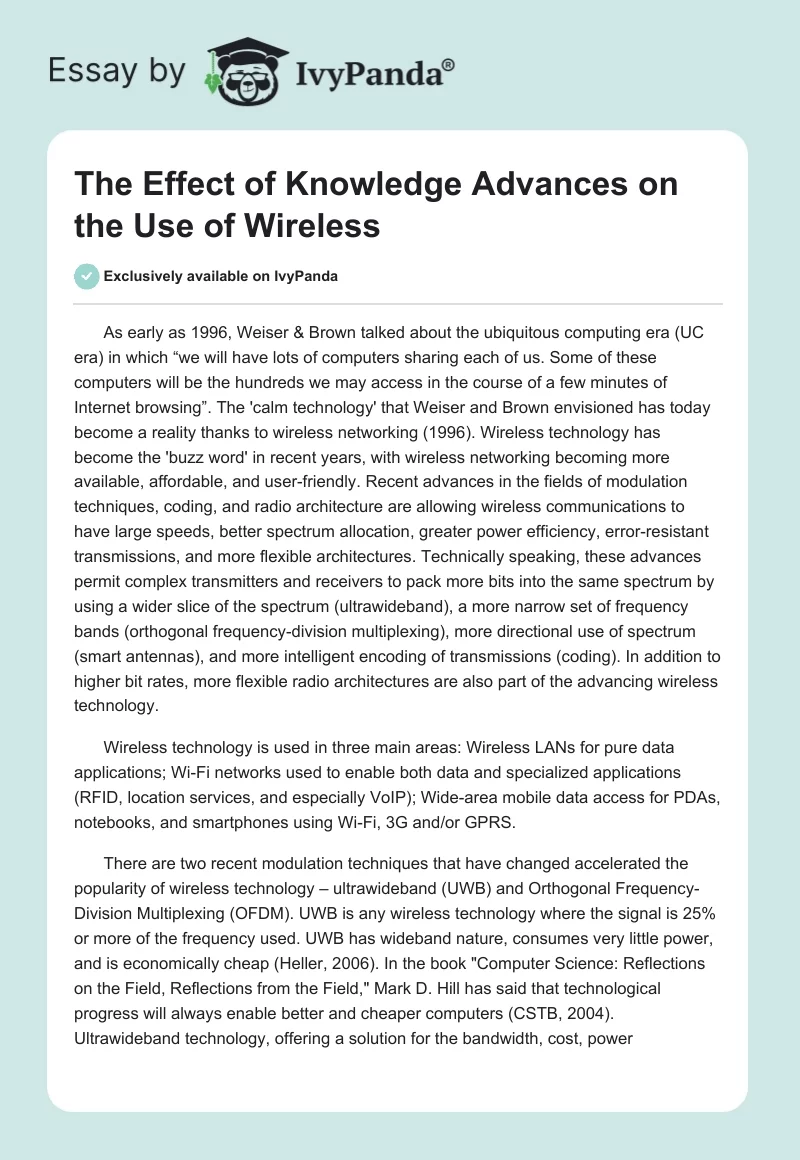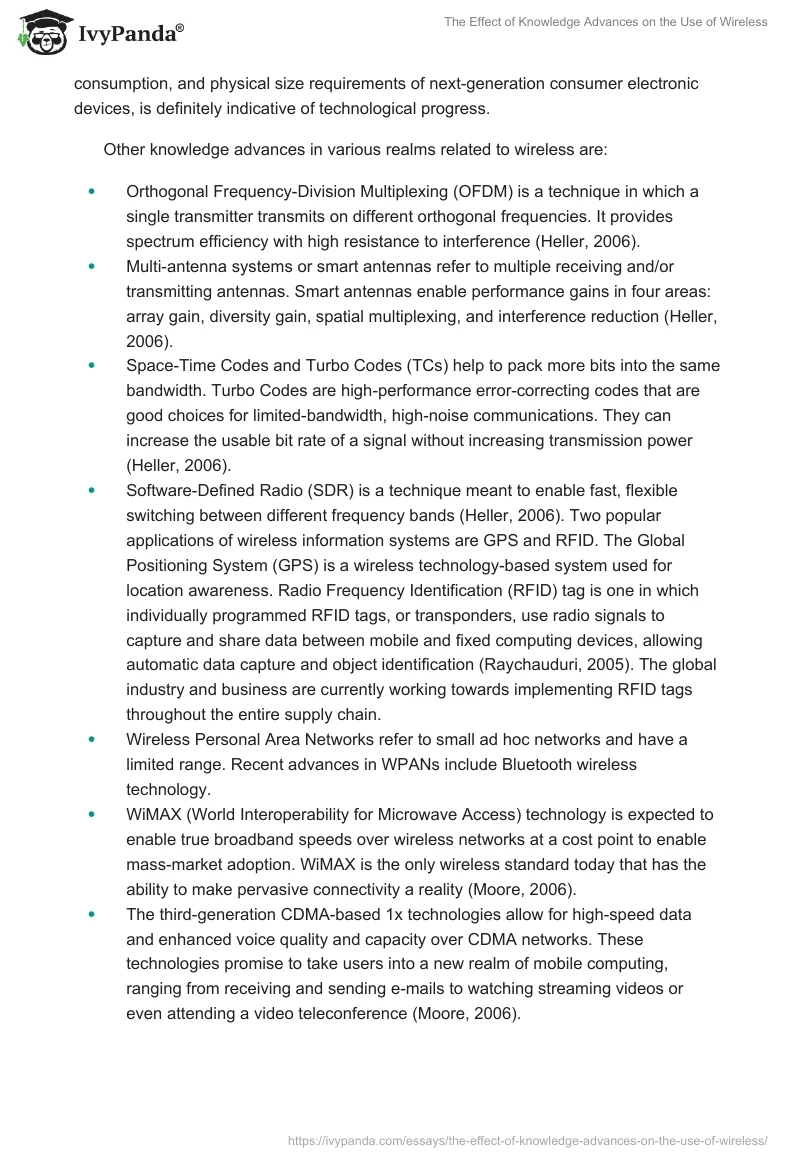As early as 1996, Weiser & Brown talked about the ubiquitous computing era (UC era) in which “we will have lots of computers sharing each of us. Some of these computers will be the hundreds we may access in the course of a few minutes of Internet browsing”. The ‘calm technology’ that Weiser and Brown envisioned has today become a reality thanks to wireless networking (1996). Wireless technology has become the ‘buzz word’ in recent years, with wireless networking becoming more available, affordable, and user-friendly. Recent advances in the fields of modulation techniques, coding, and radio architecture are allowing wireless communications to have large speeds, better spectrum allocation, greater power efficiency, error-resistant transmissions, and more flexible architectures. Technically speaking, these advances permit complex transmitters and receivers to pack more bits into the same spectrum by using a wider slice of the spectrum (ultrawideband), a more narrow set of frequency bands (orthogonal frequency-division multiplexing), more directional use of spectrum (smart antennas), and more intelligent encoding of transmissions (coding). In addition to higher bit rates, more flexible radio architectures are also part of the advancing wireless technology.
Wireless technology is used in three main areas: Wireless LANs for pure data applications; Wi-Fi networks used to enable both data and specialized applications (RFID, location services, and especially VoIP); Wide-area mobile data access for PDAs, notebooks, and smartphones using Wi-Fi, 3G and/or GPRS.
There are two recent modulation techniques that have changed accelerated the popularity of wireless technology – ultrawideband (UWB) and Orthogonal Frequency-Division Multiplexing (OFDM). UWB is any wireless technology where the signal is 25% or more of the frequency used. UWB has wideband nature, consumes very little power, and is economically cheap (Heller, 2006). In the book “Computer Science: Reflections on the Field, Reflections from the Field,” Mark D. Hill has said that technological progress will always enable better and cheaper computers (CSTB, 2004). Ultrawideband technology, offering a solution for the bandwidth, cost, power consumption, and physical size requirements of next-generation consumer electronic devices, is definitely indicative of technological progress.
Other knowledge advances in various realms related to wireless are:
- Orthogonal Frequency-Division Multiplexing (OFDM) is a technique in which a single transmitter transmits on different orthogonal frequencies. It provides spectrum efficiency with high resistance to interference (Heller, 2006).
- Multi-antenna systems or smart antennas refer to multiple receiving and/or transmitting antennas. Smart antennas enable performance gains in four areas: array gain, diversity gain, spatial multiplexing, and interference reduction (Heller, 2006).
- Space-Time Codes and Turbo Codes (TCs) help to pack more bits into the same bandwidth. Turbo Codes are high-performance error-correcting codes that are good choices for limited-bandwidth, high-noise communications. They can increase the usable bit rate of a signal without increasing transmission power (Heller, 2006).
- Software-Defined Radio (SDR) is a technique meant to enable fast, flexible switching between different frequency bands (Heller, 2006). Two popular applications of wireless information systems are GPS and RFID. The Global Positioning System (GPS) is a wireless technology-based system used for location awareness. Radio Frequency Identification (RFID) tag is one in which individually programmed RFID tags, or transponders, use radio signals to capture and share data between mobile and fixed computing devices, allowing automatic data capture and object identification (Raychauduri, 2005). The global industry and business are currently working towards implementing RFID tags throughout the entire supply chain.
- Wireless Personal Area Networks refer to small ad hoc networks and have a limited range. Recent advances in WPANs include Bluetooth wireless technology.
- WiMAX (World Interoperability for Microwave Access) technology is expected to enable true broadband speeds over wireless networks at a cost point to enable mass-market adoption. WiMAX is the only wireless standard today that has the ability to make pervasive connectivity a reality (Moore, 2006).
- The third-generation CDMA-based 1x technologies allow for high-speed data and enhanced voice quality and capacity over CDMA networks. These technologies promise to take users into a new realm of mobile computing, ranging from receiving and sending e-mails to watching streaming videos or even attending a video teleconference (Moore, 2006).
Pervasive computing is the next generation computing environment with information & communication technology everywhere, for everyone, at all times. As early as 1976, Newell writes that someday, computer technology may incorporate intelligent behavior into objects (CSTB, 2005). We can create “frozen action to be thawed when needed,” and the action can be conditional on the state of the world. In accordance with the above visionary statement, Prof. D. Raychaudhuri says that wireless systems are evolving from today’s centrally managed cellular and WLAN services towards ad-hoc heterogeneous networks capable of supporting a broad new class of “pervasive computing” applications (Raychauduri, 2005). Enabling technologies for this pervasive computing scenario include infostation (wireless cache), multimodal wireless sensors, self-organizing ad-hoc network protocols, and cognitive radio (Raychauduri, 2005). In just five years, Raychauduri believes, networks of embedded devices will be all around us (Raychauduri, 2006).
As wireless networks are shared, management and security are two major issues to be considered. With certain LAN standards (of good bandwidth), a license is needed to operate. Wireless devices are sometimes susceptible to interference from other devices such as cordless phones that also operate in the same frequency band. Even Bluetooth devices sitting in close proximity can cause interference. The wireless medium is time-division multiplexed, meaning a client can either send or receive data at a time, but not both, and moreover, the actual transmission rate is dictated by physical factors like indoor settings and the quality of equipment used. Since a wireless network uses shared bandwidth, the throughput reduces as the number of clients increases. Security could be an issue in a wireless environment, as anybody in the vicinity can try to hack into the access point.
Some other problems to be overcome are data integrity, speed, protection, compatibility, and environmental safety (Eremin, 2005). A more serious drawback is that standards are lacking in wireless networking, which is why very few wireless products can work with one another (Eremin, 2005).
Bibliography
- “Future Directions in Wireless Technology” by Prof. D. Raychaudhuri, February 2005, SUNY Stony Brook. Download PowerPoint presentation
- Alexei A.Eremin, (2004) Effects of wireless computing technology. Pushkin Computing College.
- Computer Science and Telecommunications Board (2004). Computer Science: Reflections on the Field, Reflections from the Field. National Academy of Sciences Press.
- Heller, Brandon. The Quest for Wireless Gigabit: Recent Advances in the Wireless Physical Layer. 2006. Web.
- Mark Weiser and John Seely Brown (1996). The Coming Age of Calm Technology. Xerox PARC.
- Moore, K. Linda (2006). Wireless Technology and Spectrum Demand: Advanced Wireless Services. CRS Report for Congress. Web.
- Raychauduri (2006). Pervasive Wireless. Technology Review – published by MIT. Web.


